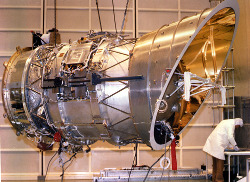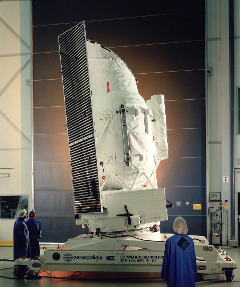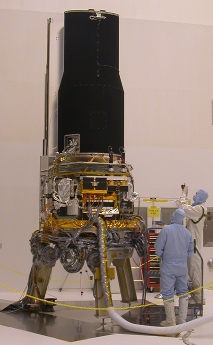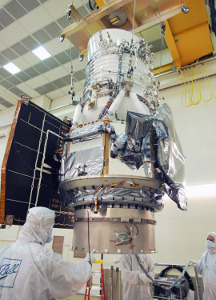
Normal stars emit most of their energy at optical wavelengths that our eyes can see, but forming stars and dying stars are embedded deep inside dust clouds. The dust is opaque in the optical and hides these important stages in a star's life from us. If we want to understand how stars are born and how they die, we have to observe at infrared wavelengths.
Infrared astronomy is challenging from the ground because the Earth's atmosphere absorbs most infrared radiation. Only certain wavelengths get through; most wavelengths are blocked completely. If you want to study astronomical objects across the entire infrared spectrum, you have to launch telescopes into space.
This webpage describes the four infrared space telescopes most important to my own research over the past couple of decades. There have been other infrared space telescopes, but we'll focus on these.

|
| Photo credit: unknown |
The Infrared Astronomical Satellite (IRAS) was launched in 1983. It was designed and operated jointly by NASA, the Dutch, and the British, and it was the first infrared telescope to orbit the Earth. For the next ten months, it surveyed nearly the entire sky at 12, 25, 60, and 100 µm. Its mirror was only 22 inches across, but the survey was truly revolutionary, with nearly 250,000 point sources detected. Three decades later, we still haven't exhausted the science in the IRAS archives.
Because evolved stars buried beneath their own dust shells dominate the infrared skies, IRAS proved to be a very powerful tool in understanding the nature of these stages of stellar evolution. One of its instruments on board was the Low-Resolution Spectrometer (LRS), which obtained several thousand spectra covering the 8-22 µm wavelength range. This range is ideal for studying dust around evolved stars, because most forms of dust show strong emission or absorption features at these wavelengths.

|
| Photo credit: ESA |
The Infrared Space Observatory (ISO) was a mission by the European Space Agency that launched in 1995. The telescope was only slightly larger than IRAS, with a 24-inch mirror, but with new detector technology, it was much more sensitive. It operated for over two years. While IRAS was a survey instrument, ISO performed pointed observations, with astronomers submitting proposals for what it should look at.
Of the four instruments on board ISO, I have been most closely involved with the Short-Wavelength Spectrometer, which took over 1,200 spectra covering the entire 2-45 µm range. I worked with Steve Price on a project to recalibrate all of these spectra. The result was the SWS Atlas.

|
| Photo credit: Greg Sloan |
The Spitzer Space Telescope began its life as SIRTF in the early 1980s, which at the time stood for Shuttle Infrared Telescope Facility. Once NASA realized that the cargo bay of the space shuttle was not a good place for a telescope, SIRTF became the Space Infrared Telescope Facility After three cancellations and redesigns, SIRTF launched in August, 2003 and was rechristened the Spitzer Space Telescope.
Spitzer has a telescope diameter of 33 inches, significantly larger than IRAS or ISO. While small compared to ground-based observatories, the suite of advanced infrared detectors and its location above the atmosphere gave Spitzer an unprecedented sensitivity. My research with IRAS and ISO focused on stars inside our own Galaxy, but with Spitzer, we could study similar stars in nearby galaxies as far as 140,000 parsecs away (450,000 light years).
Spitzer differed from IRAS and ISO by being passively cooled. To operate properly, infrared telescopes have to stay cold. The previous missions were actively cooled with liquid helium and were basically flown in giant thermos bottles. But Spitzer was designed so that it always flew in the shadow of its own solar panels and just radiated any excess thermal energy away into space. That design change saved weight and allowed us to fly a larger telescope.
Spitzer exhausted its onboard supply of liquid helium in April, 2009, which ended the cryogenic phase of its mission. One of the three instruments can still operate (partially) without cryogens, and so Spitzer is still functioning in what NASA calls the warm mission.
In 2001, I came to Cornell and joined the team developing the Infrared Spectrograph (IRS), one of three instruments on Spitzer. We worked pretty hard getting ready for launch, and after that, there was no let-up because we found ourselves in a torrent of awesome scientific data! But we had a lot of fun through it all. It was a sad day when Spitzer ran out of cryogens, but I have to admit that life got a little calmer after that!

|
| Photo credit: NASA |
The Wide-field Infrared Survey Explorer was NASA's next infrared space telescope. The telescope only has a 16-inch mirror, but because infrared detectors keep improving, it has roughly 1000 times the sensitivity of IRAS. WISE launched in December, 2009, exhausted its coolant in October, 2010, and ended its mission in February, 2011. In the ten months it operated at cryogenic temperatures, it surveyed the entire sky at 3.4, 4.6, 12, and 22 µm.
WISE has already produced many exciting results, especially on Near-Earth Objects in our Solar System and brown dwarfs among the stars near the Sun, but it will take years for astronomers to digest the results from such a powerful survey. A mission like WISE will have an impact for quite some time, much like IRAS.
Last modified 16 December, 2014. © Gregory C. Sloan.